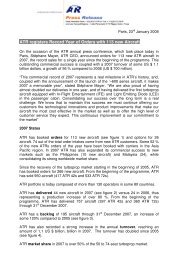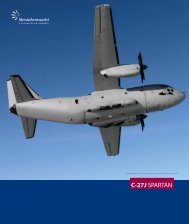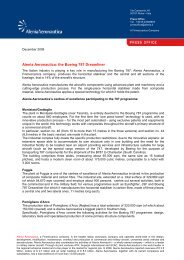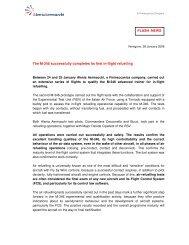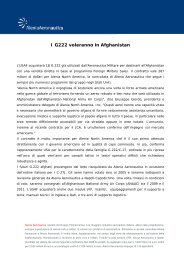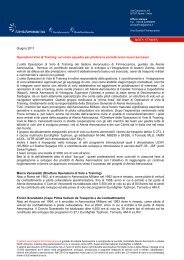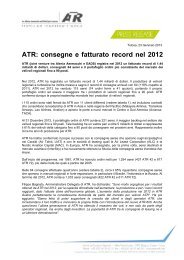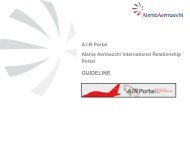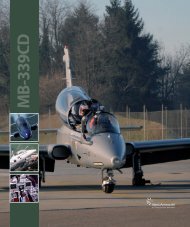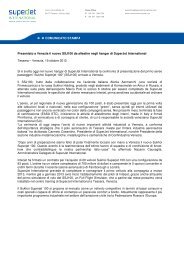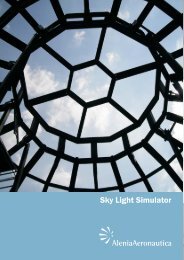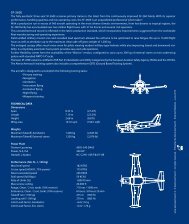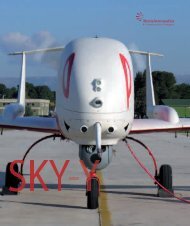Alenia Aermacchi M-311
Alenia Aermacchi M-311
Alenia Aermacchi M-311
You also want an ePaper? Increase the reach of your titles
YUMPU automatically turns print PDFs into web optimized ePapers that Google loves.
Via Campania, 45<br />
00187 Rome - Italy<br />
Press Office<br />
Tel. +39 06 42088985<br />
pressoffice@alenia.it<br />
A Finmeccanica Company<br />
June 2011<br />
<strong>Alenia</strong> <strong>Aermacchi</strong> M-<strong>311</strong><br />
The M-<strong>311</strong> is the new <strong>Alenia</strong> <strong>Aermacchi</strong> solution for the basic-advanced fast jet phase of the pilot training<br />
syllabus. Within the <strong>Alenia</strong> <strong>Aermacchi</strong> trainer range, the M-<strong>311</strong> provides the most cost effective overall<br />
training solution for future military pilots.<br />
The new light weight <strong>Alenia</strong> <strong>Aermacchi</strong> M-<strong>311</strong> jet trainer offers a significant reduction in acquisition and lifecycle<br />
costs, bringing them to a level similar to that of the heavy weight high power turboprops. These<br />
turboprops are in the same weight class and are equipped with similar systems, entailing similar<br />
maintenance and operating costs, but which much more limited performance and teaching effectiveness.<br />
The M-<strong>311</strong> was designed for a two-level maintenance concept: Organisation and Intermediate.<br />
Enhancement to aircraft maintainability comes from excellent accessibility to the systems and the built-in<br />
Health and Usage Monitoring System (HUMS) providing the airframe, engine and systems monitoring<br />
required easing maintenance and assessing residual airframe life. The introduction of pressure refuelling<br />
and of an On-Board Oxygen Generating System (OBOGS) brings significant reductions in manpower<br />
required for maintenance. This allows very short turn-around-time, which offers the potential to generate<br />
more sorties per day, making the aircraft even more affordable.<br />
Airframe has been designed for a fatigue life of 15,000 flight hours with fatigue spectrum allowing a<br />
significant use to perform also the more demanding basic-advanced missions. The maximum manoeuvre<br />
load factors are of +7 / -3.5 g at 3,200kg clean. The mid by-pass ratio turbofan engine (Pratt & Whitney<br />
Canada JT15D-5C) provides 1.447 kg (3,190 lb) of takeoff and maximum continuous thrust.<br />
The aircraft state of the art avionics includes a full digital glass-cockpit with three LCD MFDs 5'' x 7'' for both<br />
front and rear cockpit, HOTAS control, two mission computers for redundancy, embedded GPS/ Inertial<br />
Platform, a HUD in the front cockpit and a rear cockpit repeater. All six MFDs are identical. The new basicadvanced<br />
trainer will sport the embedded simulation introduced in the <strong>Alenia</strong> <strong>Aermacchi</strong> advanced trainers,<br />
the MB-339CD and the M-346, as well as a Stores Management System and a Digital Moving Map.<br />
Finmeccanica’s aeronautical sector is led by <strong>Alenia</strong> Aeronautica and includes the wholly owned companies <strong>Alenia</strong> <strong>Aermacchi</strong> and<br />
<strong>Alenia</strong> North America, together with its participation in jvs and consortia like ATR, SuperJet International, Eurofighter and GMAS.<br />
Finmeccanica’s aeronautical sector has a role of primary importance in the world’s civil and defence aeronautical industry, counts a<br />
total workforce of ca. 12,600 people and operates in the design, development, production and integrated support of commercial and<br />
military aircraft, trainers, unmanned aerial vehicles and aerostructures. In 2010 it reported revenues of € 2.8 billions, orders of € 2.5<br />
billions and a backlog of € 8.6 billions.
M-<strong>311</strong> TECHNICAL DATA<br />
Dimensions<br />
Span 8,47 m 27.78 ft<br />
Length 9,85 m 32.32 ft<br />
Height 3,74 m 12.27 ft<br />
Wing area 12,60 sqm 135.6 sqft<br />
Weights<br />
Takeoff (clean) 3.200 kg 7,055 lb<br />
Weapon Load, maximum 1.000 kg 2,205 lb<br />
Takeoff (maximum) 4.100 kg 9,040 lb<br />
Power Plant<br />
Pratt & Whitney Canada<br />
JT15D-5C<br />
Max Thrust, SLS (Takeoff and MCP) 1.447 kg 3,190 lb<br />
Internal fuel capacity (usable) 696 kg 1,535 lb<br />
Performance (clean, ISA)<br />
Max level speed (SL/20,000 ft)<br />
Limit speed<br />
Rate of climb (S.L.)<br />
Stall speed (landing, 20% fuel)<br />
Service ceiling<br />
Ferry range clean/2 external tanks (10% reserve)<br />
Max sustained load factor (S.L., 50% fuel)<br />
Sustained load factor, 360 kts (S.L., 50% fuel)<br />
80 / 400 KTAS<br />
430 KCAS / 0.80 Mach<br />
4,720 ft/min<br />
84 KCAS<br />
40,000 ft<br />
750 / 970 nm<br />
3.9 g<br />
2.3 g<br />
Takeoff ground run (S.L.) 470 m 1,540 ft<br />
Landing ground roll (S.L., 20% fuel) 460 m 1,510 ft<br />
Limit load factor<br />
+7 / - 3.5 g



